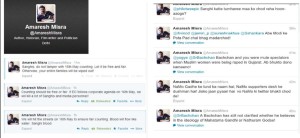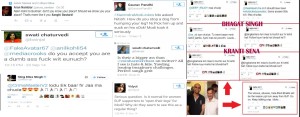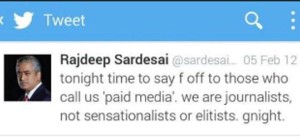When some of us friends meet and talks are exhausted, we
often watch funny videos. Ham movies like Gunda and ham videos are quite a rage
because they give us talking points for some more time. Pakistani media’s clips
are among our favorites. I wondered why it is that Pakistani media and
intellectual classes are full of hilariously idiotic elements and who does the thinking
for them? I figure now that the best minds at the disposal of Pakistan in media
and intelligentsia are journalists and panelists holding Indian Aadhar cards!
Thus when the government of India raised the issue of Human
Rights violations in Balochistan and PoK, frenzy was expected in the colony of
pro-Pakistan brain rats, and frenzy we had! A confused enemy is your best
friend in the battle, he might give away all of his future moves in the
confusion.
The diplomatic escalation of Balochistan & PoK probably
came too unexpectedly to allow a planning of the narrative and Aadhar-holder
Pakistani brains have given away quite a few themes for their future narrative designed
for the sole objective of dissuading India from building pressure on Pak &
exposing its excesses in Balochistan & PoK. Discussing a few that have been
identified:
The
Bhaago-bhoot-aaya (Run ye! The ghost cometh) theme:
Practitioners of this theme will try to scare India off with
rumors of the ghost of Pakistan’s righteous might!
Articles appearing will argue based on UN resolution on
Kashmir and Shimla agreement and how India, by talking about Human Rights
violation, an internal matter of Pakistan, India is in breach of Simla
Agreement but Pakistan “doing the rights violations” and also sending
terrorists, violating cease fire on LoC repeatedly is not because Pakistan is
itself a victim of terror which has no religion.
Some will argue that this will internationalize the Kashmir
issue and put India in a tenuous position internationally and that it will be a
great fall from the position achieved during the previous regime. As it is they
have largely pushed themselves hard to make themselves unaware of India’s
diplomatic gains in recent times and this practiced innocence garnished with
staged vehemence will serve them well.
The “Two unholies
doth make not a pilgrimage” theme
Although these particular views presented in continuation
and representing a continuous thought look innocuously moralistic and preachy
at best, the come from the factory of marshmallows with a bitter gourd candy
core. It talks about “a nation that backs terrorism” and one would presume the
reference is to Pakistan… or is it? With the immediate backdrop of India
raising human rights violations in Balochistan, the craftily ambiguous message
could well be for India. Even if it is for Pakistan, it predicts “the same
problem” ie. “terrorism exported by India”?!? This brings us to the next theme…
Practitioners of this theme are more futuristic in their
approach. They are pre-empting an Indian offensive on Pakistan and planting
vocabulary for the scenario. In the monsoon of outrage these seeds would bear
lush green goop of cringe inducing accusations. The main target consumers of
this theme would be internationally acclaimed rags like NYT whose pens are
filled with gallons of bile which could digest Modi in a wink!
Saffron terrorism shall be back and it shall now have
religion as opposed to secular terrorism! Loud TV debates will be held where
entire platoons of sharp shooting “humanist” voices will be aiming at a lone
BJP spokesperson who will be fighting them and then a very bad throat.
India’s head will be sought daily on the alters of the
humanity they envisage,
notwithstanding that India is a sixth of all humanity and it’s interests would
serve humanity more than that of the humane secular terrorists. Questions like
“Do two wrongs make a right” and “Has India degenerated into a terrorist nation
while trying to pin the charge on Pakistan” will dominate prime time debates.
Modi will be equated with the most (un)popular hate icon of the world- Hitler.
Charges of warmongering and fascism will be leveled against him.
The Indian army will be equated with terrorists, RAW with
ISI and all of Pakistan’s crimes will be justified in India by the Indian
Aadhar card holding Pakistani voices. Amnesty will institute reports on how
India has almost brought humanity to the brink. Other out-of-job FCRA violating
NGOs will hold peace marches near Rashtrapati Bhavan, get angry pictures
clicked which shall make it to front pages and coup-fiction writers will
gleefully call each picture a Tiannamen moment on twitter!
The “I sense
darkness in your forces” or “Darth Vader” theme
This theme also preempts a war but is more sinister than the
“Two unholies doth make not a
pilgrimage” theme. It does not see the army as a single unit of evil but
seeks to divide it into saffron evil and under-the-command-of-saffron evil. It
shall work through allegations on tough talking formidable leaders in the
defense forces, build opinion and cause disaffection against them. The end goal
may be to instigate resentment in the armed forces themselves, through
sustained public mudslinging on decorated Indian generals and the government
leading them.
It has an added benefit that in the eventuality of a setback
to India, the peaceful nation Pakistan, or peaceful religious ideologies shall
not be blamed. The blame shall rest with the saffron war machine infested with
evil hindutva ideology! It is just as amenable to International propaganda,
lobbying and outrage.
The “Special agent
Gaandhari” theme:
This theme is very simple, efficient and effective.
Logically it displays the same spectacular lack of erudition of the “Why launch
Mangalyaan when there are poor and hungry in India” argument, but it is much
more potent than that.
Just like Gaandhari’s deliberate blindness, it is
deliberately blind to the fact that raising issues of human rights violations
by Pakistan is just a more honest version of the frivolous ranting and poking
that Pakistan does against India over Kashmir, in effect, giving Pakistan a
taste of its own medicine. Only Pakistan is actually sick and the medicine
would be more bitter.
This clever theme actually works to Pakistan’s advantage
because:
·
It claims that India in apathetic to Kashmir and
thus subtly jstifies the separatist violence with Indian apathy, while
obscuring the role of Pakistan in instigating the violence. This chief engineer
of this theme is also going Gaandhari over the confessions by arrested
Pakistani terrorist Bahadur Ali, of Pakistani hand in manufacturing violence.
Pakistan would be shedding tears of gratitude!
·
Claiming Indian apathy in Kashmir and delinking
Balochistan and Kashmir would also imply that India is being adventurist in
Balochistan for its own sake. This can then be blamed on hypernationalism and
position Pakistan as the victim of “communal” and “Islamophobic” hindu
nationalist ambitions…. Pakistan should send a high level delegation just to
land kisses of gratitude on such intellectuals!
Staying blind to obvious truths, this theme serves Pakistan while
maintaining an veneer of innocence & concern for Kashmiris. This is a
beautiful sabotage that accomplished secret agents can pull off! Hence the
theme.
The
“Inconsequentialis Irritatus” theme
Founders of this theme belong to the esteemed
“If-Kashi-Why-Not-Gyanvyapi” school of thoughtlessness. They possess a high
pedigree in monkey-balancing and produce opinions with little real value but
very high nuisance value. Their claim to fame is that they are not taken
seriously by anyone but generate a lot of outrage!
Usually such mindless tweets are followed by the noble quest
to drown evil internet yindoos in gallons of Bloody Mary through some
ideologically funny articles. Meaning, if you are laughing at the supposed
humor/satire it’s only because you are fighting for the ideology. As the theme
suggests, these are inconsequential opinions which irritate you a lot.
Although, the presentation above is composed to look
light-hearted and sarcastic, the analysis is not intended to be taken lightly.
Many fronts are opening up, many narratives are in the
making. If there is to be strife, it shall have to be dealt with on the ground
by the leaders and their forces, and in the intellectual space by free minds
who care for each other’s and the nation’s future. Facts, information, the
right perspective and unity in testing times are the weapons at our disposal.
They are to be used with diligence and to good effect.









